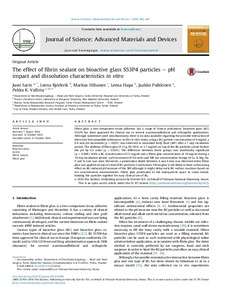The effect of fibrin sealant on bioactive glass S53P4 particles – pH impact and dissolution characteristics in vitro
Pekka K Vallittu; Jussi Sarin; Jaakko Pulkkinen; Leena Björkvik; Markus Hiltunen; Leena Hupa
https://urn.fi/URN:NBN:fi-fe2021042715808
Tiivistelmä
Fibrin glue, a
two-component tissue adhesive, has a range of clinical indications. Bioactive glass (BG) S53P4 has been approved for clinical use
in several craniomaxillofacial and orthopedic applications. Although sometimes
used simultaneously, there is no data available regarding the possible
interaction of these two biocompatible substances. In this in vitro study, using a BG particle concentration of 4 mg/ml, a 0.4
unit pH increment (p<0.001) was observed in simulated body fluid (SBF) after
a 7-day incubation period. The addition of fibrin glue (0.13 g, SD 0.04; or 3.7
mg/ml) on top of the BG particles raised further the pH by 0.5 units
(p<0.001). The difference between these groups was statistically significant
(p=0.008). With a BG concentration of 25 mg/ml and a fibrin glue concentration
of 18 mg/ml during a 14-day incubation period, a pH increment of 0.6 units and
SBF ion concentration change of Ca, K, Mg, Na, P and Si ions was seen. Moreover,
a penetration depth between 4 and 6 mm was observed when fibrin glue was
applied on top of a bed of BG particles. Conclusions: Fibrin glue is not likely
to have a distracting effect on BG-induced pH increase of the SBF although it
might delay early BG surface reactions based on ion concentration measurements.
Fibrin glue penetrated to the interparticle space to some extent, binding the
particles together for easy clinical use of BG.
Kokoelmat
- Rinnakkaistallenteet [19207]
